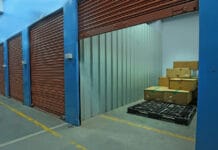Organising reusable bags is a simple yet effective way to declutter your space. Whether you’re in the middle of a renovation or just tidying up, these bags often end up scattered. By using box storage or self-storage solutions, you can keep them in order. For example, designate a small box near your kitchen for grocery bags. Label it clearly so everyone knows where to find them.
Consider a wall-mounted organizer in your pantry for easy access. If you have a larger collection, self-storage bins can help keep them out of sight but within reach. These methods save space and make your home renovation projects smoother and your daily routines more efficient.
Why Organising Reusable Bags Matters?
Organizing reusable bags is more important than you might think. Properly stored bags are easier to find when needed, reducing clutter and saving valuable space in your home. For example, instead of having bags scattered around the kitchen or pantry, you can store them in a labelled box or hang them on a hook by the door. This simple organization makes your home tidier and more efficient.
Beyond convenience, organizing reusable bags also has a positive environmental impact. When bags are easy to access, you’re more likely to use them regularly, reducing the need for single-use plastic bags. This promotes sustainability by cutting down on waste. Additionally, an organized home encourages eco-friendly habits, like reusing bags for shopping, storage, or even lunch totes.
Step-by-Step Guide to Organising Reusable Bags
Step 1: Declutter and Sort
The first step to organizing your reusable bags is to declutter. Start by gathering all your bags in one place. Sort them by size, use, or location. For example, group grocery bags separately from a tote or smaller produce bags. This helps you see what you have and decide what you need. If you have duplicates or worn-out bags, it’s time to let them go. Decluttering makes it easier to find the right bag when needed, and it’s an essential part of renovation preparation.
Step 2: Choose the Right Storage Solutions
Once you’ve sorted your bags, it’s time to choose the proper storage solutions. Consider using box storage for larger bags that you don’t use often. A small, labelled box can easily fit under a kitchen counter or closet. Self-storage bins are great for keeping bags neatly folded and out of sight but accessible. Try wall-mounted organizers in your pantry or mudroom if you want something more visible. These keep bags within easy reach while saving space. For those who are short on space, a compact storage option like a hanging bag organizer is a perfect solution.
Step 3: Designate Storage Locations
After selecting your storage solutions, decide where to place them. The kitchen is a popular spot for grocery bags, while the pantry can house bulkier totes. If you frequently use reusable bags on the go, keep a stash in your car for easy access. Think strategically about where you’ll need the bags most so you don’t have to search for them. This makes it convenient and efficient.
Step 4: Maintain the Organization
Finally, maintaining your organized system is critical. Regularly declutter your bags to keep only what you need. Label storage boxes and bins clearly so everyone knows where to put and find bags. By keeping up with this simple maintenance, your bags will always be organized, making your home more functional and less cluttered.
Creative Storage Ideas to Organise Reusable Bags
Thinking outside the box can make a big difference when organising reusable bags. Here are some creative storage ideas that save space and keep your bags easily accessible.
Hanging Bags: A straightforward solution is to hang your reusable bags. You can use hooks or pegs in a pantry or closet. For example, hang a sturdy hook behind your kitchen door. This keeps bags off the floor and easy to grab when needed.
Rolling Bins: If you have an extensive collection of reusable bags, consider using a rolling bin. These bins can be stored in a closet or under a counter. When you need a bag, roll the bin out. It’s perfect for families who use multiple bags regularly.
Foldable Boxes: Foldable storage boxes are another great option. These boxes can collapse when not in use, saving even more space. You can keep them in your car trunk or under the sink. For instance, a small foldable box in your car ensures you always have grocery bags handy.
These innovative solutions are easy to implement and help optimize your space, making staying organized and environmentally friendly easier.
Environmental Benefits of Reusable Bag Organisation
It’s a small step that can significantly impact the environment. When your reusable bags are neatly stored and easily accessible, you’re more likely to use them regularly. This reduces the need for single-use plastic bags, which often end up in landfills or oceans, contributing to pollution.
For example, if your reusable bags are always within reach—whether in your kitchen, car or even in a handy storage box by the door—you’ll naturally reach for them instead of grabbing a plastic bag when heading out. This simple habit helps reduce waste, making your household more eco-friendly. Every time you use a reusable bag, you save one less plastic bag from entering the environment.
Moreover, by organizing your reusable bags, you also ensure they last longer. Crumpled or lost bags don’t get used, and when they’re tucked away neatly, they’re kept in better condition, extending their lifespan. This means fewer bags must be bought or replaced, reducing waste.
Let’s say you’re in the habit of keeping a small box of neatly folded reusable bags in your car. When you go grocery shopping, those bags are ready for use, helping you avoid single-use plastic bags. Repeated over time, this habit makes a noticeable difference in reducing your household’s environmental footprint.
Conclusion
Organising your reusable bags is a simple yet powerful way to make your home more efficient and environmentally friendly. By keeping them in designated spots—like a storage box in the kitchen, a hook by the door, or a bin in the car—you’re more likely to use them regularly. This helps declutter your space and reduces your reliance on single-use plastic bags, making your lifestyle more sustainable.
The benefits of this small act extend beyond your home. Every time you use a reusable bag, you contribute to reducing waste and protecting the environment. Over time, these efforts add up, significantly impacting the amount of plastic that ends up in landfills and oceans.
FAQs
A: Organizing reusable bags ensures they are easily accessible, promoting regular use. This helps reduce reliance on single-use plastic bags, contributing to a more sustainable and eco-friendly lifestyle.
A: Simple ways to organize reusable bags include box storage, hanging organizers, wall hooks, or self-storage bins. Designate locations in your kitchen, car, or pantry for easy access.
A: In small spaces, consider using foldable boxes, wall-mounted organizers, or compact hanging systems. You can also roll or fold the bags tightly to save space.
A: Organizing reusable bags encourages frequent use, reducing the need for single-use plastic bags. This helps lower plastic waste and supports sustainable living practices.
A: Keep reusable bags where you’re likely to need them, such as in your car, near the door, or in the kitchen. This makes them easy to grab when heading out.
A: Box storage keeps your reusable bags organized, prevents clutter, and makes them easy to find. It also protects the bags from crumpling or damage, extending their lifespan.
A: Yes, you can fold or roll your reusable bags and store them in a drawer, cabinet, or a designated spot in your pantry or closet without extra storage items.
A: Worn-out reusable bags can be recycled if made of recyclable materials. If they’re too damaged, consider repurposing them for storage or as lining for trash bins.
A: Place reusable bags in visible, convenient locations so everyone can access them. Clearly label storage boxes or hooks and remind family members about the environmental benefits.








